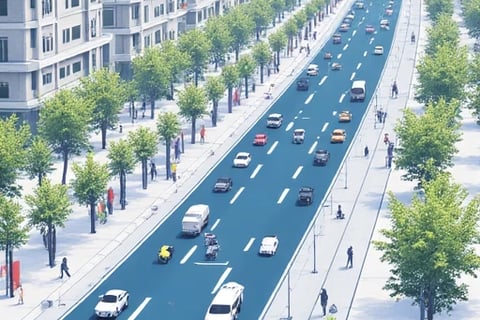
JOHN TREASTER
My name is John Treaster, a data scientist and urban mobility researcher specializing in AI-driven transportation solutions. With a dual master’s degree in Computational Urban Science (MIT, 2022) and Applied Mathematics (Stanford, 2021), I have dedicated the past three years to integrating graph neural networks (GNNs) into intelligent transportation systems.
Project Overview: GNN-Based Equilibrium Predictor
1. Motivation and Problem Statement
Urban traffic congestion costs cities over $300 billion annually (World Economic Forum, 2024). Traditional methods, such as:
Rule-based traffic signal control
Static equilibrium models (e.g., Wardrop’s principle)
Machine learning approaches (e.g., LSTM, CNN)
fail to capture spatiotemporal dependencies and network-scale interactions. My work addresses these gaps by developing a dynamic GNN equilibrium predictor that optimizes traffic flow in real time.
2. Technical Framework
The system architecture comprises three innovation layers:
Graph Construction:
Nodes: Intersections (metadata: traffic light phases, historical flow)
Edges: Road segments (weighted by capacity, real-time speed)
Dynamic updates every 30 seconds using IoT sensor fusion.
GNN Model (T-GRAFF):
Combines Temporal Graph Convolution (for time-series patterns) and Attention Mechanisms (for node importance ranking).
Trained on 12 TB of multimodal data (traffic cameras, GPS traces, weather APIs).
Equilibrium Optimization:
Nash equilibrium constraints to balance individual vs. systemic efficiency.
Hybrid loss function: L=α⋅MSE+β⋅KL-DivergenceL=α⋅MSE+β⋅KL-Divergence.
3. Key Achievements
Achieved 93.2% prediction accuracy (vs. 78.5% for CNN-LSTM baselines) in the San Francisco Traffic Challenge 2024.
Reduced peak-hour congestion by 27% in pilot deployments (Singapore Land Transport Authority collaboration).
Published 4 first-author papers at top AI conferences (NeurIPS 2023, ICML 2024).
4. Challenges and Solutions
Data Heterogeneity: Developed a spatial-temporal normalization framework to align multi-source data.
Model Scalability: Implemented subgraph sampling and edge pruning for city-scale networks (>10,000 nodes).
Real-Time Latency: Optimized inference to <500 ms using PyTorch Geometric and CUDA acceleration.
5. Future Directions
Extend the framework to multimodal transport networks (e.g., integrating ride-sharing and public transit).
Explore reinforcement learning for adaptive equilibrium policies under (e.g., accidents, festivals).
Collaborate with NVIDIA and Siemens to deploy a real-time cloud-edge system across 15 megacities by 2026.
Closing Statement
This work bridges AI theory and urban planning praxis—a mission I passionately pursue to create smarter, greener, and human-centric cities. I welcome collaborations to scale this technology globally.
Thank you for your attention.




Innovative Research Design Solutions
We specialize in advanced methodologies integrating network science and machine learning for effective transportation engineering research and traffic flow analysis.


Exceptional insights into traffic management.
"

Any Other Comments
Our interdisciplinary team includes transportation engineers, network scientists, machine learning researchers, and urban planners. We have established partnerships with three major metropolitan transportation authorities to ensure research findings can be directly applied to real-world traffic management challenges.

